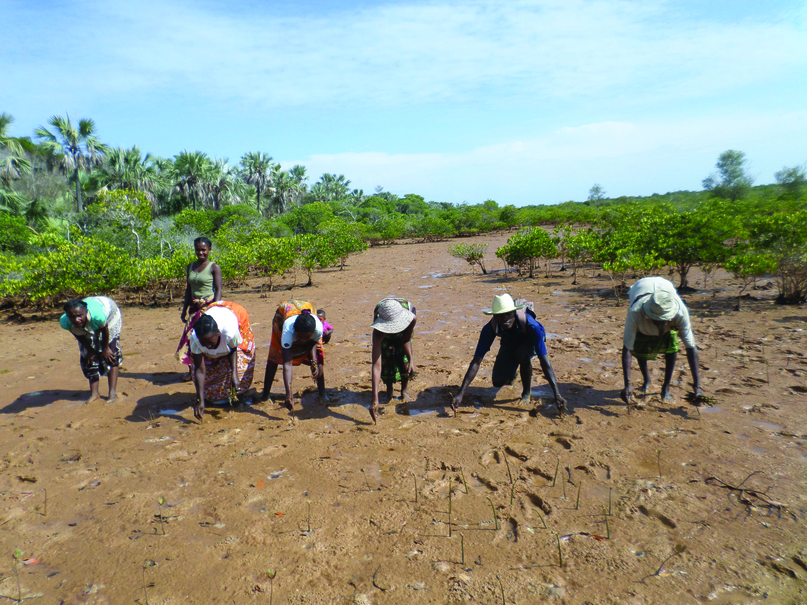Mangroves

Local people plant mangrove propagules in a restoration effort at the Mahavavy-Kinkony Wetland Complex in Madagascar. ITTO promotes the conservation, restoration and sustainable management and use of mangrove forest resources in the tropics. Photo: Asity
Mangroves are among the Earth’s most productive ecosystems. These communities of salt-adapted trees, shrubs, palms and ferns produce many goods and environmental services essential for the livelihoods of coastal communities, including sustaining fisheries, conserving biodiversity, and storing among the highest densities of carbon of any ecosystem globally. Mangroves reduce the vulnerability of coastal regions to storm surges and other threats and regulate estuarine and coastal water quality through sedimentation and nutrient uptake.
For centuries, mangrove forests have sustained the traditional cultures of coastal populations as a source of fish and game, woodfuel, medicines, tannins and fodder for livestock. And they have supported the development of industries that use them as a source of raw materials for paper, chipboard, charcoal and construction.
Mangroves cover about 15 million hectares worldwide but are under threat, with the total area declining by at least 20% since 1980. At least one-quarter of surviving mangroves are moderately to severely degraded due to poor management and increasing demand for coastal lands for development. A high priority for the global community, therefore, is arresting mangrove loss and restoring degraded mangrove ecosystems.
Evidence and case studies demonstrate that, with adequate investment, sustainable mangrove management can play a significant role in conserving and enhancing carbon sinks, enabling adaptation to climate change. Sustainable mangrove management will be important for achieving UN Sustainable Development Goals (SDGs) 5 (“gender equality”), 13 (“climate action”), 14 (“life below water”) and 15 (“life on land”). Local people—especially women—are key agents for ensuring that mangroves perform their crucial roles at the land–sea margins.
ITTO, the governments of Indonesia and the Province of Bali, and the International Society for Mangrove Ecosystems hosted the International Conference on Sustainable Mangrove Ecosystems in April 2017. Among other things the conference produced the Bali Call to Action, which urges all stakeholders to “redouble their work to ensure the conservation, restoration, protection and sustainable management and use of the world’s remaining mangrove forest ecosystems”.
ITTO promotes the conservation, restoration and sustainable management and use of mangrove forest resources in the tropics. It does this through both policy development and projects aimed at optimizing the contributions of mangrove restoration and sustainable management to the SDGs and the Paris Agreement on climate change.
For centuries, mangrove forests have sustained the traditional cultures of coastal populations as a source of fish and game, woodfuel, medicines, tannins and fodder for livestock. And they have supported the development of industries that use them as a source of raw materials for paper, chipboard, charcoal and construction.
Mangroves cover about 15 million hectares worldwide but are under threat, with the total area declining by at least 20% since 1980. At least one-quarter of surviving mangroves are moderately to severely degraded due to poor management and increasing demand for coastal lands for development. A high priority for the global community, therefore, is arresting mangrove loss and restoring degraded mangrove ecosystems.
Evidence and case studies demonstrate that, with adequate investment, sustainable mangrove management can play a significant role in conserving and enhancing carbon sinks, enabling adaptation to climate change. Sustainable mangrove management will be important for achieving UN Sustainable Development Goals (SDGs) 5 (“gender equality”), 13 (“climate action”), 14 (“life below water”) and 15 (“life on land”). Local people—especially women—are key agents for ensuring that mangroves perform their crucial roles at the land–sea margins.
ITTO, the governments of Indonesia and the Province of Bali, and the International Society for Mangrove Ecosystems hosted the International Conference on Sustainable Mangrove Ecosystems in April 2017. Among other things the conference produced the Bali Call to Action, which urges all stakeholders to “redouble their work to ensure the conservation, restoration, protection and sustainable management and use of the world’s remaining mangrove forest ecosystems”.
ITTO promotes the conservation, restoration and sustainable management and use of mangrove forest resources in the tropics. It does this through both policy development and projects aimed at optimizing the contributions of mangrove restoration and sustainable management to the SDGs and the Paris Agreement on climate change.
Related links
-
See photos, presentations, outputs and videos of the International Conference on Sustainable Mangrove Ecosystems
(held 2017)
-
See presentations from the ITTO side-event at UNFCCC COP23 Mangroves in the tropics: realizing their potential for climate-change mitigation and adaptation
(presented 2017)
-
Download the Bali Call to Action and an associated brochure
(published 2017)
- Download the Bali Call to Action brochure
-
Download Holding the ground on mangroves, a special edition of the Tropical Forest Update
(published 2017)
-
Download editions of the International Society for Mangrove Ecosystems’ Mangrove Educational Book Series
(published 2013)
-
Download Mapping mangroves, a special edition of the Tropical Forest Update
(published 2012)
-
Download Securing the Future of Mangroves, a policy brief
(published 2012)
-
See information on the World Atlas of Mangroves
(published 2010)
- See the Global Mangrove Database and Information System
-
Download ITTO Mangrove Work Plan 2002–2006
(published 2002)
- See ongoing mangrove projects
- See completed mangrove projects